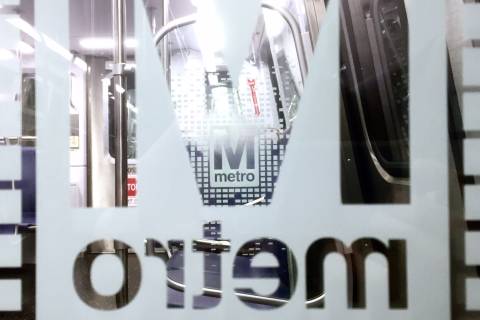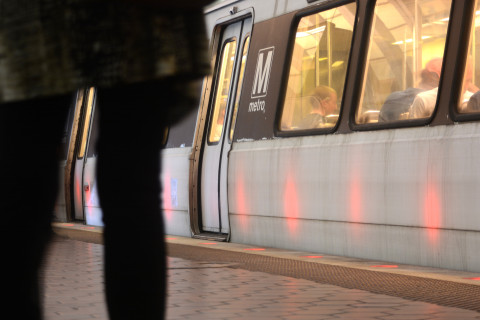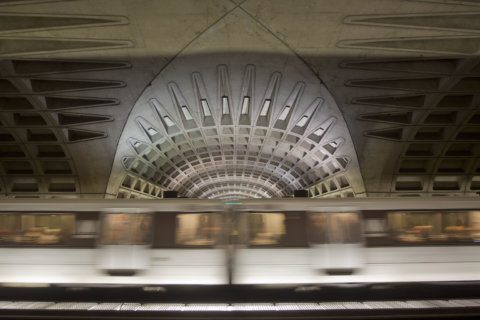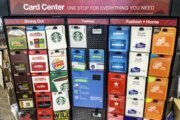
Ahead of a major shutdown, Metro said more riders are happy with their rail trips even as fewer people are taking the train.
Metro’s latest quarterly report card shows ridership is below projections and down from the prior year on both rail and bus. With ridership down, it means less fare and parking revenue, but Metro has cut costs for workers and contract services, so it remains ahead of budget.
Metrorail’s weekday average ridership for July through March is listed at 594,000, down 0.9%, while average weekend rail ridership is down 1.9% to 190,000.
Metro partly blames the federal government shutdown this winter, along with ongoing track work.
Metrobus ridership is down 3 to 4%, with an average — calculated by farebox use — of 356,000 trips on weekdays. Metro is also now counting bus ridership using automated passenger counters, but even though those show a slight increase in ridership, it is still 3% below forecast.
While Metro’s customer satisfaction rating for bus sits at 75%, Metro said its rail customer satisfaction rating has jumped from 73% this fall to 80% this winter.
In the prior two full years, Metro said customer satisfaction had risen from 69% in 2017 to 76% in 2018.
About 88% of Metrorail trips scored as on time from July through March. Green Line riders are most likely to be on time, while Blue and Orange Line riders are least likely to be on time.
Seventy-six percent of weekend rail trips were counted as on time from July through March based on the maximum scheduled wait at that time of day, the time it takes to get to and from the platforms, and the time it should take to actually make the trip.
Metro’s report card for January, February and March notes slightly better weekend results this winter — 79% on time — with changes to track work schedules.
Besides track problems and staffing issues, police investigations and rider issues, such as medical emergencies, account for about 40% of unplanned delays, and railcar issues account for about one-third of the delays.
Metro’s railcars are breaking down less frequently, though, now that Metro has retired some of its worst-performing cars that never got midlife overhauls; repairs have been made to other railcars; and new trains are performing better. Metro now has more than 652 of the 748 new railcars, with the remainder expected by the end of this calendar year.
According to Metro, smoke and fire incidents are down 20% now compared with the same point last year, and emergency single-tracking incidents are being resolved much more quickly now.
Elevators also did better in January, February and March, with 97% available, after some lower numbers in the six months prior. Metro is considering a dedicated elevator maintenance team systemwide, rather than the current setup of specific crews responsible for both elevators and escalators in a specific part of the system. Metro is also hiring a total of 11 elevator and escalator support “helpers” to “increase the rigor and timeliness of inspections and maintenance.”
Escalators are available 94% of the time.
The overall number of serious crimes in the Metro system has declined in the first nine months of the budget year compared with the same period a year earlier, but the rate of crimes against people as opposed to property increased 12%.
The combined rail and bus crime rate is now down to 3.6 crimes per million trips.
Bus problems
While there may be improvements on the rails, the bus system is a different story.
Buses are breaking down more frequently — going 11% fewer miles between failures that disrupt service. Distance between failures that cause a service disruption for hybrid buses — which are supposed to run more than 60% of Metro’s service — dropped 17% compared with last year. Metro and the bus manufacturer are looking at a number of issues, some of which are also slowing the buses at other transit agencies.
And Metro is still trying to resolve data problems that have prevented the calculation of a new bus on-time performance measure for nearly a year. The agency expects to finish software fixes this month, to allow calculations to begin in July.
On-time performance could improve this summer though with new bus lanes in the District and a focus on moving buses through Alexandria during the rail shutdown of all six Blue and Yellow Line stations south of Reagan National Airport.
Buses are also crashing more frequently.
The overall collision rate is 66 per million miles — up from 61.1 this time last year.
The number of collisions bus drivers could have avoided is up 19% compared with the same time a year earlier — 29.5 per million miles, up from 24.8 at this point last year.
Preventable collisions involved hitting streetlights, sideswiping or rear-ending cars, and hitting parked cars. There have been 21 people walking or biking hit by Metrobuses between July and March, the majority in incidents that the bus driver could have avoided.
The collisions have helped drive the Metrobus customer injury rate to 2.84 per million trips, a slight drop from the prior year, but still above Metro’s targets.
The bus employee injury rate also remains higher than Metro would like, but has fallen significantly from a spike. Now, the rate is 11 injuries per 200,000 hours worked, most commonly due to collisions, slips and falls, and stress or assault.
The rail rider injury rate is 1.47 per million trips, just above target and slightly lower than last year’s rate at this time.
The MetroAccess customer injury rate has dropped significantly this year to 2.18 per 100,000 trips, compared with 2.54 at this point last year.
For MetroAccess, service cuts cut into on-time performance numbers. Ninety-one percent of trips were counted as on time. MetroAccess has promised scheduling improvements and better consideration of road closures in routing trips.








